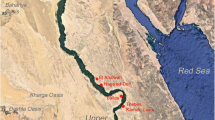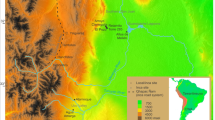Abstract
Amara West, built around 1300 BC, was an administrative centre for the pharaonic colony of Upper Nubia. In addition to producing hand- and wheel-made pottery, respectively, in Nubian and Egyptian style, Amara West also imported a wide range of ceramics from Egypt and the eastern Mediterranean. A scientific study of 18 Mycenaean-style ceramics was undertaken to study provenance and aspects of production technology. Neutron activation analysis (NAA) results show that the pots were imported from several workshops in Greece and Cyprus. Thin-section petrography and scanning electron microscopy, used with energy-dispersive spectroscopy (SEM-EDX), show that different recipes were used to make the fabrics and paints of Mycenaean ceramics, reflecting both technological choices and the range of raw materials used in the different workshops. The petrographic and SEM-EDX results support the NAA provenance attributions.










Similar content being viewed by others
References
Beier T, Mommsen H (1994) Modified Mahalanobis filters for grouping pottery by chemical composition. Archaeometry 36:287–306
Budka J (2015) The pharaonic town on Sai Island and its role in the urban landscape of new kingdom Kush. Sudan Nubia 19:40–53
Buxeda i Garrigós J, Mommsen H, Tsolakidou A (2002) Alterations of Na, K and Rb concentrations in Mycenaean pottery and a proposed explanation using X-ray diffraction. Archaeometry 44(2):187–198
Emery WB, Smith HS, Millard A (1979) The Fortress of Buhen: the archaeological report. Egypt Exploration Society, London
Fairman HW (1938) Preliminary report on the excavations at Sesebi (Sudla) and ‘Amārah West, Anglo-Egyptian Sudan, 1937-8. J Egypt Archaeol 24(2):151–156
Furumark A (1941) The Mycenaean pottery: analysis and classification. V. Petterson, Stockholm
Hankey V (1997) Aegean pottery at el-Amarna: shapes and decorative motifs. In: Phillips J (ed) Ancient Egypt, the Aegean, and the Near East: studies in honour of Martha Rhoads Bell. Van Siclen Books, San Antonio, pp 193–218
Hammer O, Harper D, Ryan P (2001) PAST: Paleontological Statistics Software Package for Education and Data Analysis. Palaeontologia Electronica 4(1): online
Kelder JM (2010) The Egyptian interest in Mycenaean Greece. Jaarbericht “Ex Oriente Lux” 42:125–140
Kilikoglou V (1994) Scanning electron microscopy. In: Wilson DE, Day PM (eds) Ceramic regionalism in prepalatial central Crete: the Mesara imports at EMI to EMIIA Knossos, Annual of the British School at Athens 89. British School at Athens, Athens, pp 1–87
Leonard A (1994) An index to the Late Bronze Age Aegean pottery from Syria-Palestine. Paul Åströms Forlag, Jonsered
Minault-Gout A, Thill F (2012) Saï II. Le cimetière des tombes hypogées du Nouvel Empire (SAC5). Fouilles de l'Institut français d’archéologie orientale 69. L’Institut français d'archéologie orientale, Cairo
Mommsen H (2011) Provenancing of pottery. In: International Atomic Energy Agency (ed) Nuclear techniques for cultural heritage research, IAEA Radiation Technology Series No. 2: 41–170. International Atomic Energy Agency, Vienna
Mommsen H, Kreuser A, Lewandowski E, Weber J (1991) Provenancing of pottery: a status report on neutron activation analysis and classification. In: Hughes M, Cowell M, Hook D (eds) Neutron activation and plasma emission spectrometric analysis in archaeology. British Museum Occ. Paper 82, London, pp 57–65
Mommsen H, Beier T, Diehl U, Podzuweit C (1992) Provenance determination of Mycenaean sherds found in Tell el-Amarna by neutron activation analysis. J Archaeol Sci 19:295–302
Mommsen H, Sjöberg BL (2007) The importance of the ‘best relative fit factor’ when evaluating elemental concentration data of pottery demonstrated with Mycenaean sherds from Sinda, Cyprus. Archaeometry 49:357–369
Mommsen H, Bentz M, Boix A (2016) Provenance of red-figured pottery of the classical period excavated at Olympia. Archaeometry 58:371–379
Mountjoy PA (1986) Mycenaenan decorated pottery: a guide to identification. Paul Åströms Forlag, Jonsered
Mountjoy PA, Mommsen H (2001) Mycenaean pottery from Qantir-Piramesse, Egypt. Annual of the British School at Athens 96:123–155
Mountjoy PA, Mommsen H (2015) Neutron activation analysis of Aegean-style IIIC pottery from 11 Cypriot and various Near Eastern sites. Egypt Levant 25:421–508
Müller V (2013) Die Verwaltung Nubiens im Neuen Reich. Meroitica, Schriften zur altsudanesischen Geschichte und Archäologie 18. Harrassowitz Verlag, Wiesbaden
Noll W, Holm R, Born L (1975) Painting of ancient ceramics. Angewandte Chemie International Edition, pp. 602–613
Smith ST (2003) Wretched Kush: ethnic identities and boundaries in Egypt’s Nubian empire. Routledge, London, New York
Spataro M, Millet M, Spencer N (2015) The New Kingdom settlement of Amara West (Nubia, Sudan): mineralogical and chemical investigation of the ceramics. Archaeol Anthropol Sci 7(4):399–421
Spencer N (2014) Amara West: considerations on urban life in colonial Kush. In: Anderson JR, Welsby DA (eds) The fourth cataract and beyond: proceedings of the 12th International Conference for Nubian Studies. Peeters, Leuven, Paris, Walpole MA, pp 457–485
Spencer N (2017) Building on new ground: the foundation of a colonial centre at Amara West. In: Spencer N, Stevens A (eds) The New Kingdom in Nubia: lived experience, pharaonic control and indigenous traditions. British Museum Publications on Egypt and Sudan 3. Peeters, Leuven, Paris, Walpole MA, pp 321–353
Spencer P (1997) Amara West I: the architectural report. Excavation Memoir 63. Egypt Exploration Society, London
Spencer P (2002) Amara West II: the cemetery and the pottery corpus. Excavation Memoir 69. Egypt Exploration Society, London
Steindorff G (1937) Aniba, vol. II. JJ Augustin, Glückstadt
Van Wijngaarden GJ (2002) Use and appreciation of Mycenaean pottery in the Levant, Cyprus and Italy (1600–1200 BC). Amsterdam University Press, Amsterdam
Van Wijngaarden GJ (2011) Tokens of a special relationship? Mycenaeans and the Egyptians. In: Duistermaat K, Regulski I (eds) Intercultural contacts in the ancient Mediterranean: proceedings of the international conference at the Netherlands-Flemish Institute in Cairo, 25th to 29th October 2008. Peeters, Leuven, Paris, Walpole MA, pp 225–251
Zuckerman S, Ben-Shlomo D, Mountjoy P, Mommsen H (2010) A provenance study of Mycenaean pottery from northern Israel. J Arch Sci 37:409–416
Acknowledgements
We are grateful to Director General Dr. Abd el-Rahman Ali Mohamed, National Corporation for Antiquities and Museums (Sudan), and to Shadia Abdu Rabo and Mohamed Saad, for facilitating this work and permitting the export of samples. Thanks are also due to the Egypt Exploration Society for permitting and facilitating the donation of Mycenaean sherds to the British Museum. The authors would like to thank Dr. Roberta Tomber (British Museum, UK), Dr. John Meadows (ZBSA, Germany), Dr. Penelope Mountjoy (British School at Athens, Greece) and two anonymous reviewers for their comments and discussion. The authors wish to thank also the staff of the research reactor of the Reactor Institute Delft, Delft University of Technology, for their technical support and A. Simpson (British Museum) for his help with some of the figures.
Funding
Fieldwork and analyses were funded by The Leverhulme Trust (2010–2014) and the Qatar-Sudan Archaeological Project (2014–2018), under the auspices of the National Corporation for Antiquities and Museums (Sudan).
Author information
Authors and Affiliations
Corresponding author
Electronic supplementary material
Appendix
NAA results of Mycenaean samples from the excavations at Amara West, Sudan. Raw concentrations of elements C in μg/g (ppm), if not indicated otherwise, and below, average measurement errors, also in percent of C, to indicate the precision of the NAA for the different elements (DOC 96 kb)
Rights and permissions
About this article
Cite this article
Spataro, M., Garnett, A., Shapland, A. et al. Mycenaean pottery from Amara West (Nubia, Sudan). Archaeol Anthropol Sci 11, 683–697 (2019). https://doi.org/10.1007/s12520-017-0552-z
Received:
Accepted:
Published:
Issue Date:
DOI: https://doi.org/10.1007/s12520-017-0552-z




